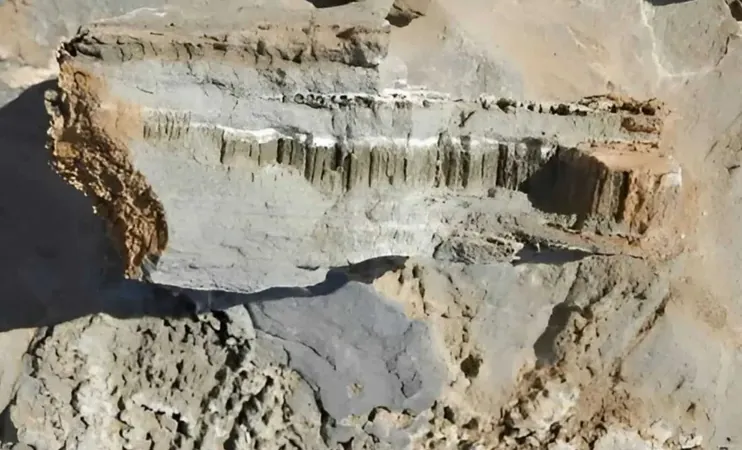
Remarkable Alien-Like Microbes Might Have Shaped Ancient Rocks with Bizarre Tunnels
2025-03-25
Author: Yan
Remarkable Alien-Like Microbes Might Have Shaped Ancient Rocks with Bizarre Tunnels
In a groundbreaking discovery deep within the marble and limestone formations of desert landscapes in Namibia, Oman, and Saudi Arabia, scientists have stumbled upon an extraordinary phenomenon: thin, carefully aligned tunnels carved through solid rock. These intricate structures, believed to have been created by enigmatic microbial life forms millions of years ago, challenge traditional geological explanations. A recent study featured in the Geomicrobiology Journal claims that these tunnels were not the result of natural erosion or geological activity but rather products of ancient endolithic organisms that thrived on the rock itself.
Unraveling the Mystery: Strange Tunnels in Ancient Stone
The investigation began in Namibia, where researchers from Johannes Gutenberg University Mainz (JGU) first identified these peculiar structures—tiny, uniform tubes measuring just half a millimeter in width and stretching up to three centimeters long, running in parallel formations through the solid stone. Subsequent research missions to Oman and Saudi Arabia further confirmed the presence of similar formations in limestone and marble.
Professor Cees Passchier from JGU, who played a pivotal role in the discovery, expressed his surprise upon recognizing that these structures were not the product of known geological processes: “These tubes are clearly not the result of a geological process.”
A Geological Enigma: Precise Formations Challenge Natural Explanations
The tunnels were encased in ancient rock formations, created under immense pressure over millions of years. What makes them particularly intriguing is their unique composition; instead of being hollow, these tunnels were filled with fine calcium carbonate powder, indicating that the organisms that created them were likely dissolving minerals for nourishment, leaving a fine dust residue in their wake.
Researchers were puzzled by the highly ordered nature of these formations, as they defied the randomness usually associated with natural erosion or crystallization processes. “We didn’t find any random patterns typical of erosion,” noted Passchier, highlighting that these burrows exhibited symmetry and laid out in carefully arranged lines across massive rock faces, extending up to ten meters.
Discovering Life Within Rocks: The Case for Ancient Endolithic Microbes
To unlock the mystery behind these ancient tunnels, the JGU team enlisted the expertise of Dr. Trudy Wassenaar, a molecular microbiologist. The working hypothesis: these tunnels were crafted by endolithic microbes, which are organisms that endure within rocks, deriving energy from chemical interactions rather than light.
“What is particularly thrilling about our discovery is that we don’t yet know what type of endolithic microorganism is responsible,” stated Professor Passchier. “Are we looking at a known organism, or could it be a previously undiscovered life form?”
Endoliths encompass a range of organisms, including bacteria, fungi, and lichens, which flourish in extreme and inhospitable environments such as deep caves and icy Antarctic regions. However, these ancient microbial traces present a unique challenge, as the DNA and proteins necessary to identify the organisms have likely deteriorated over millions of years.
The Bigger Picture: Impact on Earth’s Climate?
Beyond the immediate enigma of what life forms produced these markings lies a pressing question: what impact did they have on the rocks and the environment? If these microbes actively dissolved calcium carbonate and released carbon, they may have played a role in shifting Earth’s carbon cycle over extensive periods.
Professor Passchier suggests that the implications of such microbial activity could be far more significant for understanding global carbon balance than previously acknowledged, especially in arid deserts where these organisms might persist largely unnoticed.
“It is crucial for the scientific community to recognize the potential significance of these findings,” emphasized Passchier, urging researchers to consider the broader impact of ancient microbial life on our planet's geological and environmental history.
This fascinating study not only opens doors to understanding life in extreme conditions but also forces us to reconsider our perceptions of microbial influences on Earth’s climatic evolution throughout its history. Are we on the brink of unveiling new chapters in the story of life on our planet? Stay tuned as scientists delve deeper into this ancient mystery!






 Brasil (PT)
Brasil (PT)
 Canada (EN)
Canada (EN)
 Chile (ES)
Chile (ES)
 Česko (CS)
Česko (CS)
 대한민국 (KO)
대한민국 (KO)
 España (ES)
España (ES)
 France (FR)
France (FR)
 Hong Kong (EN)
Hong Kong (EN)
 Italia (IT)
Italia (IT)
 日本 (JA)
日本 (JA)
 Magyarország (HU)
Magyarország (HU)
 Norge (NO)
Norge (NO)
 Polska (PL)
Polska (PL)
 Schweiz (DE)
Schweiz (DE)
 Singapore (EN)
Singapore (EN)
 Sverige (SV)
Sverige (SV)
 Suomi (FI)
Suomi (FI)
 Türkiye (TR)
Türkiye (TR)
 الإمارات العربية المتحدة (AR)
الإمارات العربية المتحدة (AR)